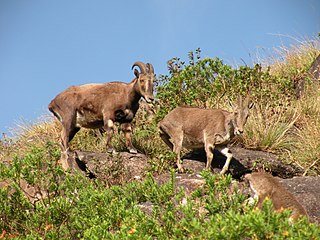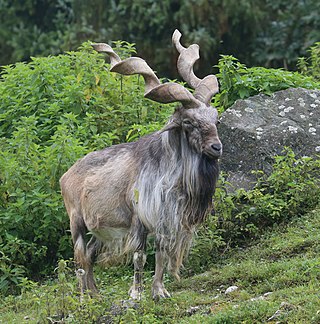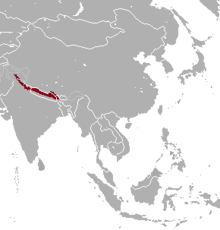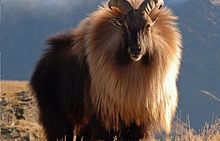
Tahrs or tehrs are large artiodactyl ungulates related to goats and sheep. There are three species, all native to Asia. Previously thought to be closely related to each other and placed in a single genus, Hemitragus, genetic studies have since proven that they are not so closely related and they are now considered as members of three separate monotypic genera: Hemitragus is now reserved for the Himalayan tahr, Nilgiritragus for the Nilgiri tahr, and Arabitragus for the Arabian tahr.

The goa, also known as the Tibetan gazelle, is a species of antelope that inhabits the Tibetan plateau.

The common brushtail possum is a nocturnal, semiarboreal marsupial of the family Phalangeridae, native to Australia and invasive in New Zealand, and the second-largest of the possums.

The chamois or Alpine chamois is a species of goat-antelope native to mountains in Europe, from west to east, including the Pyrenees, the Alps, the Apennines, the Dinarides, the Tatra and the Carpathian Mountains, the Balkan Mountains, the Rila–Rhodope massif, Pindus, the northeastern mountains of Turkey, and the Caucasus. The chamois has also been introduced to the South Island of New Zealand. Some subspecies of chamois are strictly protected in the EU under the European Habitats Directive.

The mountain goat, also known as the Rocky Mountain goat, is a cloven-footed mammal that is endemic to the remote and rugged mountainous areas of western North America. A subalpine to truly alpine species, it is a sure-footed climber commonly seen on sheer rock faces, near-vertical cliffs and icy passages. Mountain goats generally avoid venturing down into lower elevations—except during seasonal food shortages or during particularly bad weather—as the extreme elevation which they inhabit is their primary defense against predators such as black and brown bears, pumas and wolves.

Valley of Flowers National Park is an Indian national park which was established in 1982. It is located in Chamoli in the state of Uttarakhand and is known for its meadows of endemic alpine flowers and the variety of flora. This richly diverse area is also home to rare and endangered animals, including the Asiatic black bear, snow leopard, musk deer, brown bear, red fox and blue sheep. Birds found in the park include Himalayan monal pheasant and other high altitude birds.

The Nilgiri tahr is an ungulate that is endemic to the Nilgiri Hills and the southern portion of the Western and Eastern Ghats in the states of Tamil Nadu and Kerala in southern India. It is the only species in the genus Nilgiritragus and is closely related to the sheep of the genus Ovis.

Lake Pukaki is the largest of three roughly parallel alpine lakes running north–south along the northern edge of the Mackenzie Basin on New Zealand's South Island. The others are Lakes Tekapo and Ōhau. All three lakes were formed when the terminal moraines of receding glaciers blocked their respective valleys, forming moraine-dammed lakes. The Alps2Ocean mountain bike trail follows the edge of Lake Pukaki for part of its length.

The Nile lechwe or Mrs Gray's lechwe is an endangered species of antelope found in swamps and grasslands in South Sudan and Ethiopia.

The markhor is a large wild Capra (goat) species native to South Asia and Central Asia, mainly within Pakistan, the Karakoram range, parts of Afghanistan, and the Himalayas. It is listed on the IUCN Red List as Near Threatened since 2015.

The blackbuck, also known as the Indian antelope, is a medium-sized antelope native to India and Nepal. It inhabits grassy plains and lightly forested areas with perennial water sources. It stands up to 74 to 84 cm high at the shoulder. Males weigh 20–57 kg (44–126 lb), with an average of 38 kg (84 lb). Females are lighter, weighing 20–33 kg (44–73 lb) or 27 kg (60 lb) on average. Males have 35–75 cm (14–30 in) long corkscrew horns, and females occasionally develop horns, as well. The white fur on the chin and around the eyes is in sharp contrast with the black stripes on the face. Both sexes’ coats feature a two-tone colouration; in males, the majority of the body is dark brown to black, with white circles around the eyes, white ears and tail, and the belly, lower jaw, and inner legs also white. Females and juveniles are yellowish-fawn to tan and display the same white areas, only with more of a beige tone than the males. Females also feature a more pronounced horizontal white side-stripe, starting around the shoulder and ending at the rump. The blackbuck is the sole living member of the genus Antilope and was described by Carl Linnaeus in 1758. Two subspecies are recognized.

Culling is the process of segregating organisms from a group according to desired or undesired characteristics. In animal breeding, it is removing or segregating animals from a breeding stock based on a specific trait. This is done to exaggerate desirable characteristics, or to remove undesirable characteristics by altering the genetic makeup of the population. For livestock and wildlife, culling often refers to killing removed animals based on their characteristics, such as their sex or species membership, or as a means of preventing infectious disease transmission.

Gangotri National Park is a national park in Uttarkashi District of Uttarakhand in India, covering about 2,390 km2 (920 sq mi). Its habitat consists of coniferous forests, alpine meadows and glaciers. Gaumukh at Gangotri glacier, the origin of river Ganga, is located inside the park. Gangotri National Park was established in 1989.

The Arabian tahr is a species of tahr native to eastern Arabia. Until recently, it was placed in the genus Hemitragus, but genetic evidence supports its removal to a separate monotypic genus, Arabitragus.

The Western Himalayan alpine shrub and meadows is a montane grasslands and shrublands ecoregion of Nepal, India, and Tibet, which lies between the tree line and snow line in the western portion of the Himalaya Range.

The Eastern Himalayan alpine shrub and meadows is a montane grasslands and shrublands ecoregion of Bhutan, China, India, Myanmar, and Nepal, which lies between the tree line and snow line in the eastern portion of the Himalaya Range.
Graeme James Caughley was a New Zealand population ecologist, conservation biologist, and researcher. He combined empirical research with mathematical models, and supported the declining population paradigm.

Hunting is a popular recreational pursuit and a tourist activity in New Zealand with numerous books and magazines published on the topic. Unlike most other developed countries with a hunting tradition, there are no bag-limits or seasons for hunting large game in New Zealand. Hunting in national parks is a permitted activity. The wide variety of game animals and the limited restrictions means hunting is a popular pastime which has resulted in a high level of firearms ownership among civilians.
In biology, overabundant species refers to an excessive number of individuals and occurs when the normal population density has been exceeded. Increase in animal populations is influenced by a variety of factors, some of which include habitat destruction or augmentation by human activity, the introduction of invasive species and the reintroduction of threatened species to protected reserves.























